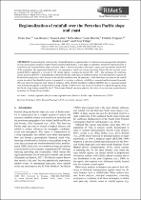Mostrar el registro sencillo del ítem
Regionalization of rainfall over the Peruvian Pacific slope and coast
| dc.contributor.author | Rau, P. | |
| dc.contributor.author | Bourrel, L. | |
| dc.contributor.author | Labat, D. | |
| dc.contributor.author | Melo, P. | |
| dc.contributor.author | Dewitte, Boris | |
| dc.contributor.author | Frappart, F. | |
| dc.contributor.author | Lavado-Casimiro, W. | |
| dc.contributor.author | Felipe-Obando, Oscar | |
| dc.date.accessioned | 2019-07-20T03:41:15Z | |
| dc.date.available | 2019-07-20T03:41:15Z | |
| dc.date.issued | 2017-01 | |
| dc.identifier.uri | https://hdl.handle.net/20.500.12542/50 | |
| dc.description.abstract | Documenting the heterogeneity of rainfall regimes is a prerequisite for water resources management, mitigation of risks associated to extremes weather events and for impact studies. In this paper, we present a method for regionalization of rainfall over the Peruvian Pacific slope and coast, which is the main economic zone of the country and concentrates almost 50% of the population. Our approach is based on a two-step process based on k-means clustering followed by the regional vector method (RVM) applied to a network of 145 rainfall stations covering the period 1964–2011. The advantage of combining cluster analysis and RVM is demonstrated compared with just applying each of these methods. Nine homogeneous regions are identified that depict the salient features of the rainfall variability over the study area. A detailed characterization of the rainfall regime in each of the identified regions is presented in response to climate variability at seasonal and interannual timescale. They are shown to grasp the main modes of influence of the El Niño Southern Oscillation (ENSO), that is, increased rainfall over downstream regions in northern Peru during extreme El Niño events and decreased rainfall over upstream regions along the Pacific slope during central Pacific El Niño events. Overall our study points to the value of our two-step regionalization procedure for climate impact studies. | en_US |
| dc.format | application/pdf | |
| dc.language.iso | eng | en_US |
| dc.publisher | John Wiley and Sons Ltd | en_US |
| dc.relation.ispartof | urn:issn:0899-8418 | |
| dc.rights | info:eu-repo/semantics/closedAccess | |
| dc.rights | Atribución-NoComercial-SinDerivadas 3.0 Estados Unidos de América | |
| dc.rights.uri | http://creativecommons.org/licenses/by-nc-nd/3.0/us/ | |
| dc.source | Servicio Nacional de Meteorología e Hidrología del Perú | es_PE |
| dc.source | Repositorio Institucional - SENAMHI | es_PE |
| dc.subject | ENSO | en_US |
| dc.subject | k-means | en_US |
| dc.subject | Peruvian coast | en_US |
| dc.subject | Peruvian Pacific slope | en_US |
| dc.subject | Rainfall | en_US |
| dc.subject | Regional vector | en_US |
| dc.subject | Regionalization | en_US |
| dc.title | Regionalization of rainfall over the Peruvian Pacific slope and coast | en_US |
| dc.type | info:eu-repo/semantics/article | en_US |
| dc.identifier.isni | 0000 0001 0746 0446 | |
| dc.description.peerreview | Por pares | |
| dc.identifier.doi | https://doi.org/10.1002/joc.4693 | |
| dc.source.volume | 37 | en_US |
| dc.source.issue | 1 | en_US |
| dc.source.initialpage | 143 | en_US |
| dc.source.endpage | 158 | en_US |
| dc.source.journal | International Journal of Climatology | en_US |
| dc.subject.sinia | precipitacion - Clima y Eventos Naturales | |
| dc.type.sinia | text/publicacion cientifica | |
| dc.identifier.url | https://hdl.handle.net/20.500.12542/50 |
Ficheros en el ítem
Este ítem aparece en la(s) siguiente(s) colección(es)
-
Artículo científico [171]








